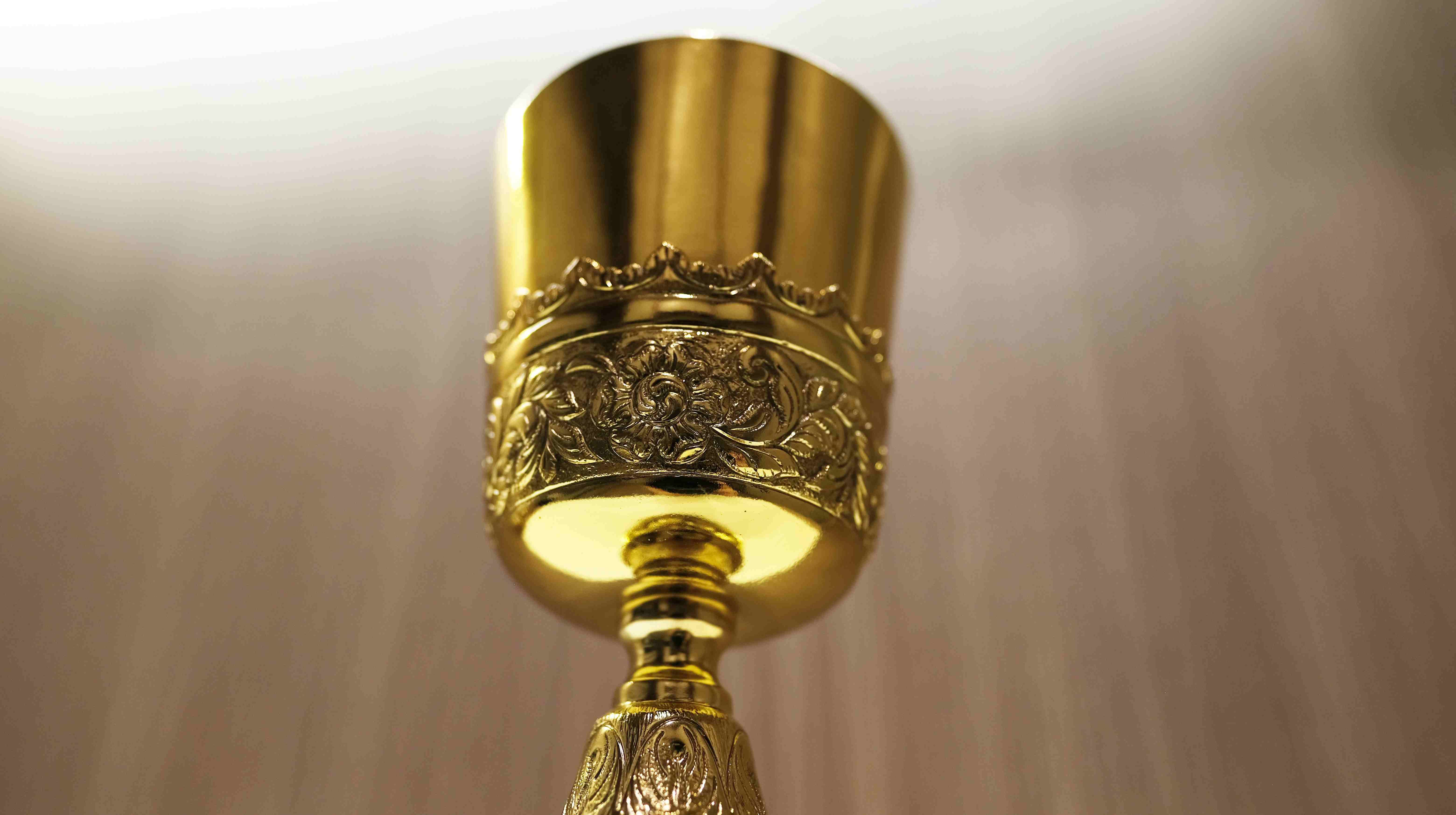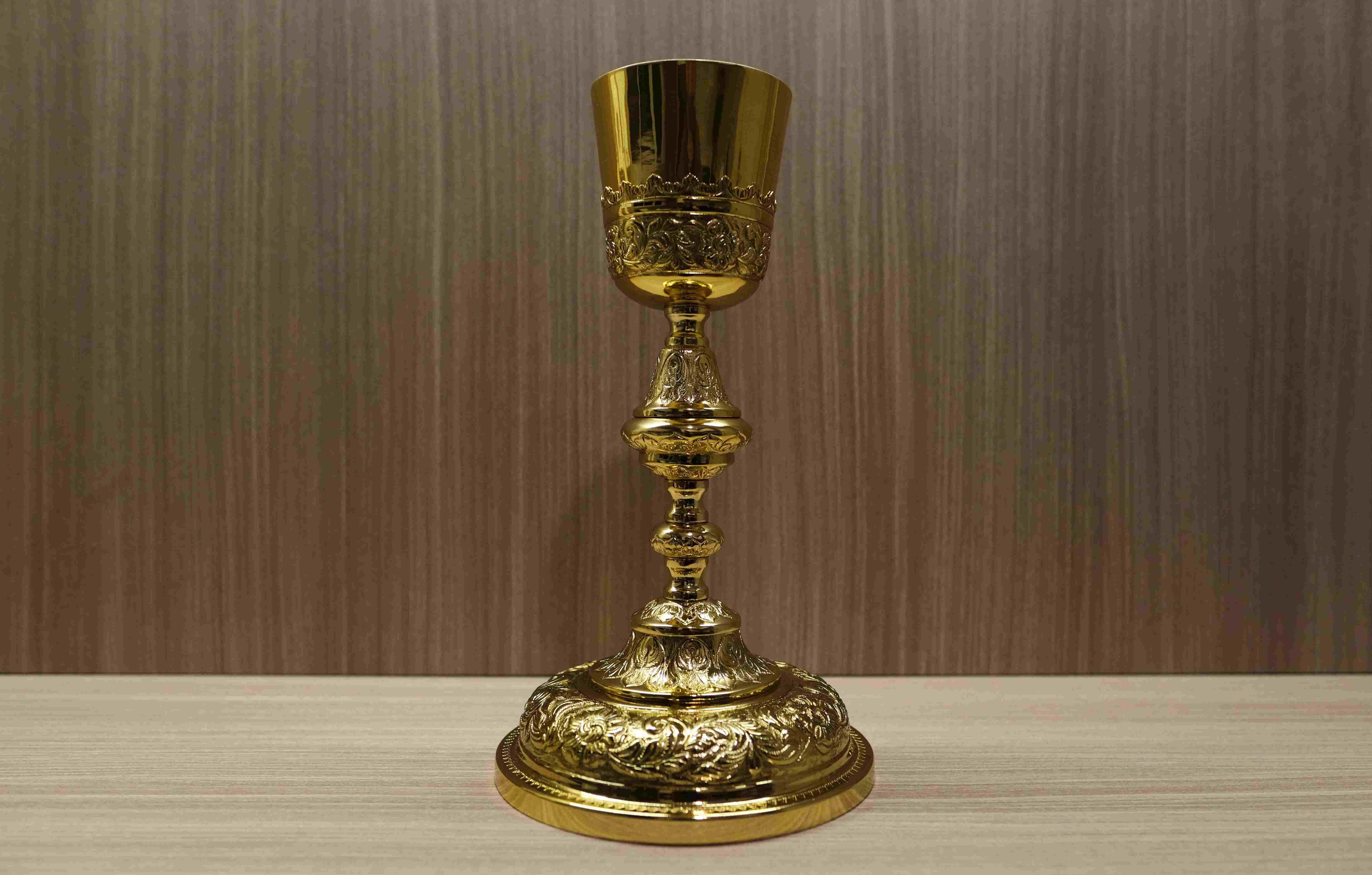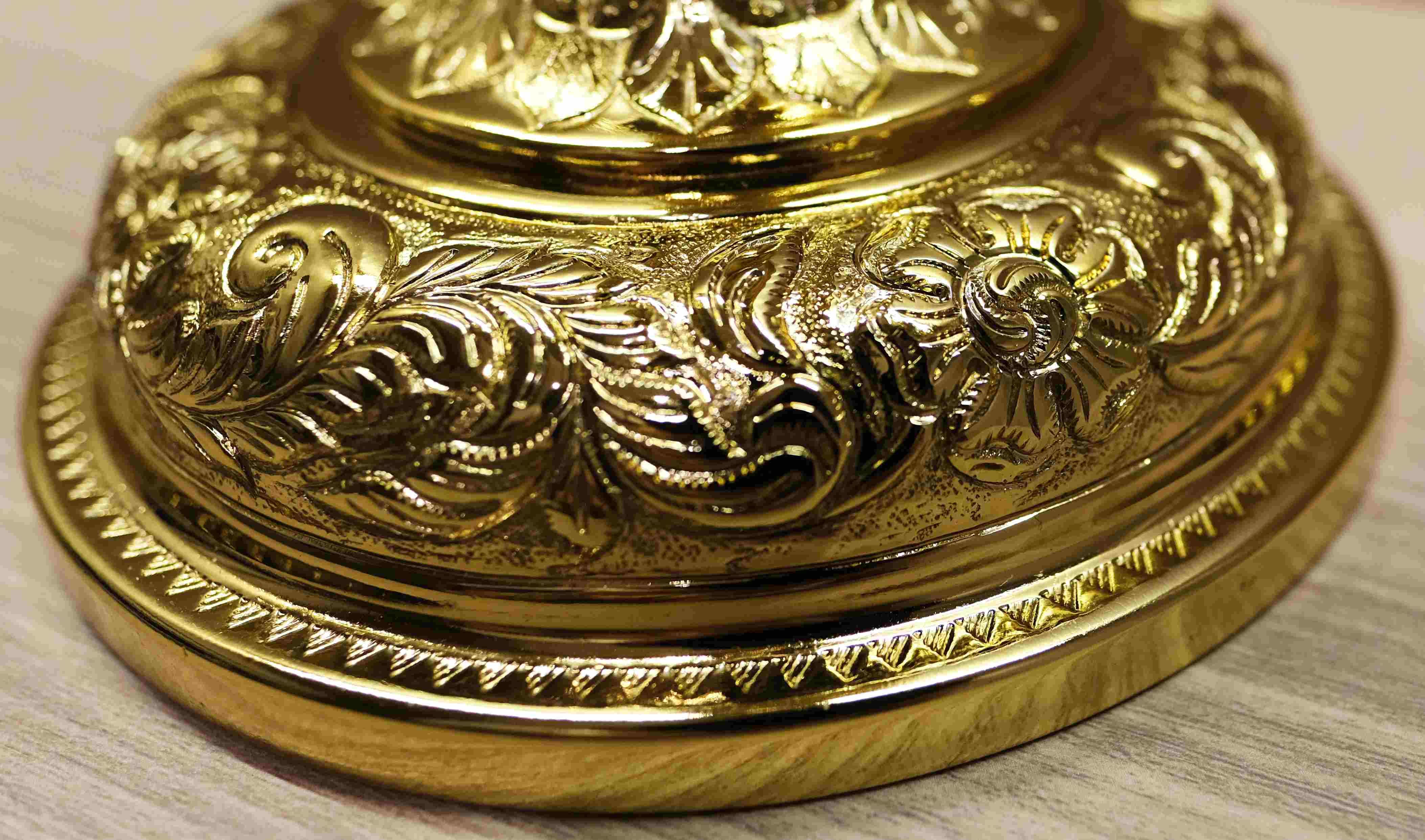
This particular chalice was made from scratch by Miguel Liturgical Products in the Philippines. Its base and stem are crafted from yellow brass that was molded and decorated by hand. The cup, however, is made of silver, a material chosen because it does not corrode when it comes into contact with the consecrated wine; by contrast, a brass cup can be corroded over time.
Several days before my ordination in 2019, it was blessed by the late Bishop of Surabaya, Vincentius Sutikno Wisaksono, who used the following prayer from the Roman Ritual:
Most gracious Father and Lord, hear our prayers, and bless ⁜ and sanctify ⁜ these vessels and ornaments of the altar prepared for the sacred ministry of thy Church. Through Christ our Lord. Amen.
Let us pray. Almighty and eternal God, by Whom all things defiled are purified, and in Whom all things purified retain their lustre, humbly we ask thy Omnipotence that the vessels and ornaments which thy servants offer unto thee, be freed from the contaminating influence of evil spirits, and that by thy blessing ⁜ they remain sanctified for divine worship. Through Christ our Lord. Amen.
It was this chalice that I had the privilege of using at my first Mass.

Recently, a jeweler friend of mine took care of replating the chalice entirely in gold. Originally, its exterior was silver-plated, while the inside of the cup was gold-plated. This occasion of its renewal has prompted me to reflect more deeply on the chalice itself: as it appears in Scripture, as it is used in the liturgy, and as it is understood by theologians.
The Story of the Chalice in Scripture
Let’s begin our reflection in the pages of Scripture. While today we reserve the word chalice for the sacred vessel of the Mass, the Bible—in its English translations—often speaks simply of a cup. But this biblical cup is rarely simple. It often becomes a powerful symbol of the destiny God assigns to people and nations. It is a two-sided coin: a cup of blessing or a cup of wrath.
For the wicked, the cup represents God’s judgment and the suffering that follows. The Psalmist paints a grim picture: “a scorching wind shall be the portion of their cup” (Psalm 11:6). Isaiah speaks in even starker terms to those who have defied God: “you who have drunk at the hand of the Lord the cup of his wrath, who have drunk to the dregs the bowl of staggering” (Isaiah 51:17).
At the same time, the cup symbolizes the profound blessings bestowed upon the faithful. We hear this in the believer’s confident prayer, “The Lord is my chosen portion and my cup” (Psalm 16:5), and we see it in the beautiful image of a life so blessed that its cup overflows (Psalm 23:5). This deep trust allows the faithful to proclaim with joy: “I will lift up the cup of salvation and call on the name of the Lord” (Psalm 116:13).
“This Is My Blood”: The Chalice of the New Covenant
This dual symbolism sets the stage for the cup’s ultimate transformation in the hands of Jesus Christ. The most famous cup in history is the one he consecrated at the Last Supper, forever linking the chalice to his own blood, the Eucharist, and the New Covenant. The accounts in the Gospels and Saint Paul’s letter vary slightly, but they all zero in on the same profound reality:
- Matthew 26:27–28: “Then he took a cup, and after giving thanks he gave it to them, saying, ‘Drink from it, all of you; for this is my blood of the covenant, which is poured out for many for the forgiveness of sins.’”
- Mark 14:23–24: “Then he took a cup, and after giving thanks he gave it to them, and all of them drank from it. He said to them, ‘This is my blood of the covenant, which is poured out for many.’”
- Luke 22:20: “And he did the same with the cup after supper, saying, ‘This cup that is poured out for you is the new covenant in my blood.’”
- 1 Corinthians 11:25: “This cup is the new covenant in my blood. Do this, as often as you drink it, in remembrance of me.”
Jesus’s choice of words was no accident. The phrase blood of the covenant intentionally hearkens back to the dramatic scene in Exodus where Moses sealed the Old Covenant. There, he sprinkled the people with the blood of sacrificed animals, declaring, “This is the blood of the covenant that the Lord has made with you” (Exodus 24:8). By using these words, Jesus signifies that his own blood establishes a new and everlasting covenant—one that, as the prophet Jeremiah foretold, would be written not on stone, but on our hearts (Jeremiah 31:31–34), bringing about an interior transformation through his ultimate gift of himself.
The Cup of Suffering, The Chalice of Life
For Jesus, the image of the cup was also deeply personal, representing his coming Passion and death. In the Garden of Gethsemane, facing his final agony, he prayed, “My Father, if it is possible, let this cup pass from me” (Matthew 26:39). This was the cup of suffering he had to drink for our sake. His total acceptance of this fate is clear when he rebukes Peter for trying to stop his arrest, asking, “Shall I not drink the cup that the Father has given me?” (John 18:11).
So how do these two cups—the cup of agony in the garden and the chalice of life at the Last Supper—fit together? The answer is found in the word sacrifice. The chalice of the Mass brilliantly unites these themes. Jesus’s words, “poured out for you,” reveal the sacrificial nature of the act. The chalice contains the blood of Christ, shed for the forgiveness of sins, making his loving sacrifice on the Cross present to us here and now. The offering at the Last Supper was an unbloody anticipation of the bloody sacrifice on Calvary. The chalice, therefore, is not merely a cup for a meal but the sacred vessel of the sacrifice that redeems the world.
One Body, One Cup
Finally, the meaning of the chalice extends from the altar into the very life of the Church. Our shared participation in the Eucharist fulfills the call for all the baptized to form one body in Christ. As Saint Paul explains, receiving from the one chalice unites us not only to Christ but also to one another: “The cup of blessing that we bless, is it not a sharing in the blood of Christ? The bread that we break, is it not a sharing in the body of Christ? Because there is one bread, we who are many are one body, for we all partake of the one bread” (1 Corinthians 10:16–17).
The Voice of the Chalice in the Liturgy
Having explored the chalice’s story in Scripture, we now turn to where it truly comes to life: the Holy Mass. The Church’s official instructions state that among all the vessels used for Mass, “the sacred vessels are held in special honor, especially the chalice and paten” (GIRM, §327). This honor is expressed not just in how the chalice is made, but in the rich tapestry of prayers that surround it from the moment it is brought to the altar.
The chalice’s journey begins at the Preparation of the Gifts. As the priest pours wine and a drop of water into it, he quietly prays about the mystery of this mingling:
By the mystery of this water and wine may we come to share in the divinity of Christ who humbled himself to share in our humanity.
Then, holding the chalice slightly raised, the priest offers the wine to God, acknowledging it as both a gift of creation and a product of human labor:
Blessed are you, Lord God of all creation, for through your goodness we have received the wine we offer you: fruit of the vine and work of human hands, it will become our spiritual drink.
As the Eucharistic Prayer begins, the chalice, sitting alongside the bread on the paten, becomes the focus of the Church’s prayer. The priest makes the Sign of the Cross over both as he prays for God to accept the offerings:
. . . and bless ⁜ these gifts, these offerings, these holy and unblemished sacrifices . . .
In a key moment before the consecration, the priest extends his hands over the offerings, pleading with the Father to transform them:
Be pleased, O God, we pray, to bless, acknowledge, and approve this offering in every respect; make it spiritual and acceptable, so that it may become for us the Body and Blood of your most beloved Son, our Lord Jesus Christ.
This prayer leads to the climax of the liturgy. Taking the chalice, the priest speaks the very words of Jesus from the Last Supper—the words that consecrate the wine into his Precious Blood:
Take this, all of you, and drink from it, for this is the chalice of my Blood, the Blood of the new and eternal covenant, which will be poured out for you and for many for the forgiveness of sins. Do this in memory of me.
As the priest elevates the chalice for the people to adore, a moment of silent awe descends. In this moment, a traditional, devotional prayer may be said quietly:
Be mindful, O Lord, of Thy creature, whom Thou hast redeemed by Thy most Precious Blood.
The Eucharistic Prayer concludes with a great crescendo of praise, the Doxology. The priest raises the paten with the Host and the chalice together, proclaiming glory to the Trinity:
Through him, and with him, and in him, O God, almighty Father, in the unity of the Holy Spirit, all glory and honor is yours, for ever and ever.
During the Communion Rite, the prayers become more intimate. The priest places a small piece of the Host into the chalice, praying quietly:
May this mingling of the Body and Blood of our Lord Jesus Christ bring eternal life to us who receive it.
Before receiving Communion himself, the priest makes a personal plea for grace, asking that the sacrament will be a source of healing, not condemnation:
May the receiving of your Body and Blood, Lord Jesus Christ, not bring me to judgment and condemnation, but through your loving mercy be for me protection in mind and body and a healing remedy.
Then, showing the Host and the chalice to the congregation, the priest proclaims the public invitation to the heavenly banquet:
Behold the Lamb of God, behold him who takes away the sins of the world. Blessed are those called to the supper of the Lamb.

Finally, right before he drinks from the chalice, a last quiet prayer is said for the priest’s own perseverance:
May the Blood of Christ keep me safe for eternal life.
The chalice’s role in the liturgy concludes with its purification. As the priest cleanses the vessel, a final prayer is offered for all who received Communion:
What has passed our lips as food, O Lord, may we possess in purity of heart, that what has been given to us in time may be our healing for eternity.
From start to finish, the liturgy clothes the chalice in a constant stream of prayer. Each word and gesture reinforces its sacred purpose: to be the vessel of the New Covenant, holding the very lifeblood of our redemption.
The Symbol of the Chalice in Theology
The simple act of veiling the chalice is itself rich with meaning. The Church’s liturgical legislation indicates that the chalice should be covered, and the General Instruction of the Roman Missal calls this a “praiseworthy practice” (GIRM, §118). This directive connects the veiled chalice to the great curtain of the Temple’s Holy of Holies, which separated a sacred space from the rest of the world.
Consequently, the removal of the veil during the Mass is a powerful moment. It echoes how the Temple curtain was torn in two at Jesus’s death, signifying that he has opened the way for us to God. What is revealed is a noble vessel, consecrated and set apart to hold the Most Precious Blood, and in its purpose and dignity, we are invited to see a reflection of ourselves.
Pope Benedict XVI provides a beautiful lens for this. Reflecting on the term praeclarus calix—the “glorious cup” mentioned in the Roman Canon—he connects it to the overflowing cup of blessing in Psalm 23. For him, the chalice represents the true feast for which all humanity longs: a “wedding-feast” between God and humanity. This is not a contract between equals, but a pure gift of God’s love. At its heart, the Eucharist transforms Christ’s death—what should be the ultimate act of separation—into the very instrument of our communion with him. The glorious cup on the altar is the sign of this indestructible friendship.
This sublime mystery, however, does not remain confined to the altar. The chalice also serves as a profound symbol of our own sacred calling. Through the Incarnation, Christ assumed human nature, consecrating it from within. This is the truth behind Saint Athanasius’s famous declaration that “the Son of God became man so that we might become God” (CCC, §460).
Through our Baptism, we are incorporated into Christ’s Body, becoming adopted children of the Father. In this way, every human person is made to be a sacred vessel, destined to receive God’s own life. The chalice on the altar, therefore, is a constant, shining reminder of our own identity. It reflects the astonishing truth that we, like that glorious cup, have been set apart by God, blessed, and called to hold his divine life within us.